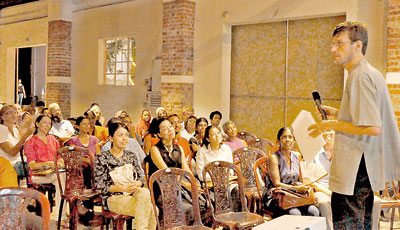Using English to learn Sinhala and Tamil
View(s):“SET,” as Michael Meyler notes, “is a book with a very short title, and a rather cumbersome subtitle: ‘a trilingual dictionary of colloquial Sinhala, English and Tamil.’” Launched last week, this is a dictionary meant for beginners studying either or both languages, with English as the point of entry. With 1300 words chosen carefully with their utility in mind, it makes no pretensions to being a comprehensive book. As dictionaries go, this is as you would expect a useful work, but it is also a surprisingly beautiful one, its word lists punctuated with some 200 detailed illustrations by artists Anura Srinath and Lynda Gill.

Book launch: Michael Meyler addresses the gathering. Pix by Susantha Liyanawatte
The book also attempts to sketch out the cultural context some words appear in with small sections such as those devoted to Tamil sweets and Sri Lankan festival days, words related to Buddhism, others that designate various familial relationships and those English ‘loanwords’ that have found their own place into the local lexicon.
Michael who first came to Sri Lanka in 1985, taught a Sinhala beginners’ class at the British Council in Colombo for 15 years. Though no longer affiliated to the British Council, he continues to teach Sinhala and beginners Tamil, the latter with co-teacher Niruba Pushparaj who along with Rakshi Thambaiah contributed a great deal to the Tamil content of this dictionary.
(Thilini Ranasinghe contributed similarly to the work on the Sinhala content.) Speaking at the launch, Michael pointed out that a “lack of practical user-friendly materials for learning Sinhala and Tamil has always been a frustration.” This dictionary attempts to fill that gap, its genesis being in the notes and materials that Michael has made in the process of learning Sinhala and Tamil himself.
As with his first book ‘A Dictionary of Sri Lankan English’, Michael brings to his task an interesting perspective, that of a foreigner who has lived and worked in Sir Lanka for a number of years. “When I started teaching English, there was a general assumption that teachers should be native speakers, and that ‘native speakers’ basically meant natives of the UK, US, Canada, Australia and New Zealand,” says Michael. “I think there is now increasing recognition that native speakers are not necessarily the best language teachers, or at least, that being a native speaker is not necessarily the most important criterion.” It cuts both ways – it’s how teachers who consider Sinhala or Tamil their mother tongue can successfully teach students English, even as non-native speakers understand a little more of the linguistic challenges Sinhala and Tamil present to other foreigners.
While Sinhala has more subtle regional variations, the difference between Indian and Sri Lankan Tamil can be quite marked, making this dictionary particularly useful for anyone planning to speak the latter. At the heart of the dictionary are the wordlists: English words in the middle column, the same word in Sinhala to the left and in Tamil to the right. The words in their original scripts are also included for reference but the reader doesn’t need to know either to navigate the text. Pronunciation is guided by a phonetic system – Sinofonetic – that Michael uses in his classes.
Discreet markings close to certain words indicate that some – such as durriyan, kovil, betel, biling and bitter gourd – are illustrated with pictures. Words likely to be unfamiliar to non-Sri Lankans are defined – think kurakkan and chena and other words that don’t really have a pithy English equivalent. Other cross-references, in red, refer to numbered usage notes which appear throughout the book integrated into the wordlists. Separate sections in between the wordlists introduce place names (you’ll find some pinpointed on a map) and countries, and numbers (labelled clocks help teach you to tell the time in both languages). Michael points out that the section on Sinhala and Tamil verbs is the only part of the book where the languages are treated separately. This final section makes sense because the two systems are quite different.
While it’s a good start, the dictionary might find more users if it were moved to other platforms. Michael, who intends to provide updates on the book via his site www.mirisgala.net, also envisions a possible digital format based on either an e-book, a CD or perhaps even an app, should the dictionary be a success.
Priced at Rs. 3,500, SET is available at Barefoot and Paradise Gallery. It can also be ordered online at www.pererahussein.com.
-S.D.
Follow @timesonlinelk
comments powered by Disqus















